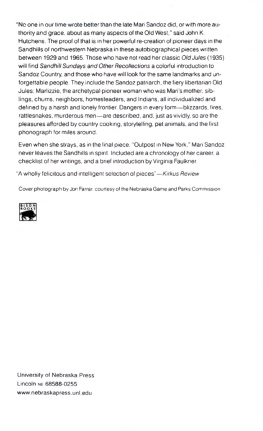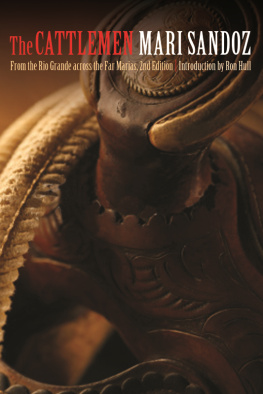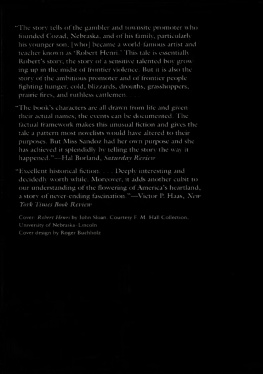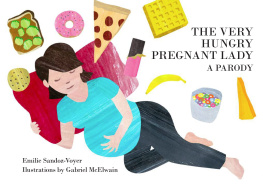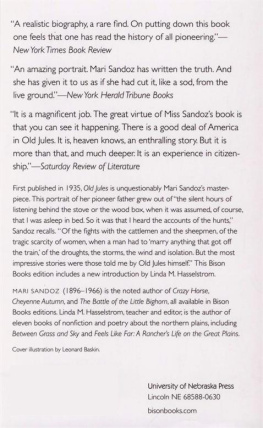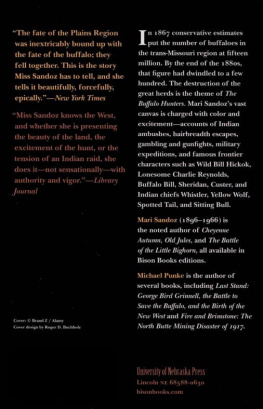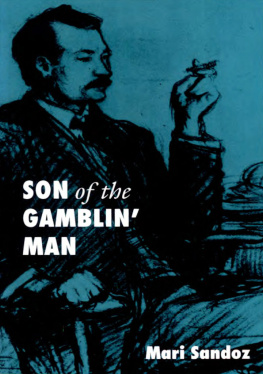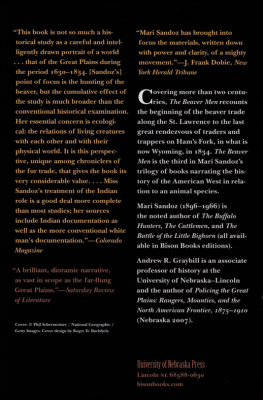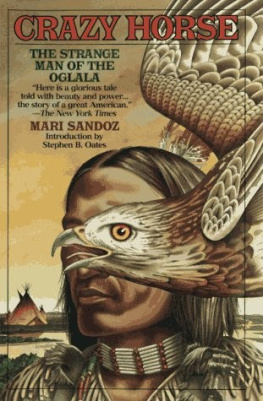
Books by Mari Sandoz published by
the University of Nebraska Press
The Battle of the Little Bighorn
The Beaver Men: Spearheads of Empire
The Buffalo Hunters: The Story of the Hide Men
Capital City
The Cattlemen: From the Rio Grande across the Far Marias
Cheyenne Autumn
The Christmas of the Phonograph Records
Crazy Horse: The Strange Man of the Oglalas
The Horsecatcher
Hostiles and Friendlies: Selected Short Writings of Mari Sandoz
Letters of Mari Sandoz
Love Song to the Plains
Miss Morissa: Doctor of the Gold Trail
Old Jules
Old Jules Country
Sandhill Sundays and Other Recollections
Slogum House
Son of the Gamblin Man: The Youth of an Artist
The Story Catcher
These Were the Sioux
The Tom-Walker
Winter Thunder

This book is a work of fiction.
Names, characters, places, and incidents either are productsof the authors imagination or are used in a fictional setting. Any resemblance to actual events or locales or persons, living or dead, is entirely coincidental .
Copyright 1930 by North American Review, Inc.
Copyright 1931, 1933, 1952 by Mari Sandoz
Copyright 1936 by Curtis Publishing Co.
Copyright 1947, 1956, 1959, 1963 by the University of Nebraska Press
Copyright 1966 by the Estate of Mari Sandoz
Copyright 1970 by the Mari Sandoz Corporation
All rights reserved
First Bison Book printing: October 1984
ISBN 0-8032-9148-5
ISBN -13: 978-0-8032-9386-1 (electronic: e-pub)
ISBN -13: 978-0-8032-9387-8 (electronic: mobi)
78-82707
The publisher does not have any control over and does not assume any responsibility for author or third-party websites or their content .
INTRODUCTION
The ten selections in this volume were written at intervals from 1929 to 1965, but it would be difficult (without referring to the bibliographical checklist) to say which was the earliest and which the latest. Before her work ever began to appear in national magazines, Mari Sandoz had served a long and gruelling apprenticeship; moreover, she decided early in her career that writers do their best work when they restrict themselves to material with which they have emotional identity. Thus, although these pieces were written over a period of thirty-seven years, they are homogeneous and uniquely Sandoz, not only in style and point of view, but in their characteristic combination of first-hand observation and creative historical vision.
The geographical setting of the first nine of the selections is Sandoz countrythe Sandhills of northwestern Nebraskaand the people who figure in them are the family and friends and neighbors, redmen and white men, whom the world first came to know in the pages of Old Jules . As for the concluding piece, Outpost in New York, in a sense it may be said to concern Sandoz country, too, for Mari Sandoz created her own climate wherever she was and she never left the West behind. The selections are arranged according to historical chronology, rather than by date of composition.
When the biography of Mari Sandoz is written, as it surely will be, the biographer will be able to avail himself of the Mari Sandoz Papers, including many hundreds of letters, now in the possession of the Sandoz Family Corporation and the University of Nebraska. But the collation and annotation of these papers is clearly a long-term project, and in planning this collection it was decided that the content should be limited to previously published work which the author herself had seen through the press. Five of the ten selections included were first published by the University of Nebraska Press, three (Martha of the Yellow Braids, The Neighbor, and Outpost in New York) in Prairie Schooner , the literary quarterly jointly sponsored by the University of Nebraskas Department of English and the UNP, and two (The Homestead in Perspective and The Christmas of the Phonograph Records) in Press books. In each instance, of course, the author reviewed the edited copy before it went to the printer, and read and okayed galley and page proof. The other five selections (The Kinkaider Comes and Goes, Sandhill Sundays, Musky, Marlizzie, and The Son) were first published elsewhere, but were collected, re-edited, and published by the UNP in Hostiles and Friendlies: Selected Short Writings of Mari Sandoz (1959). For that collection, minor cuts were made in The Kinkaider Comes and Goes, Musky, The Son, and The Neighbor to avoid repetition of detail and incident. The name Jules, Junior, which was used in The Kinkaider Comes and Goes on its first publication, was changed back to Young Jules, as it had appeared in the original manuscript, and the title Marlizzie was given to the selection first published as The New Frontier Woman. In the case of The Son, which first appeared in abridged form as What the Sioux Taught Me, the original title and the omitted portions of the text were restored. All these changes, as well as the copyediting, were discussed with and accepted by the author, who also checked galley and page proof. The changes have been retained in the present volume, and the entire text is in the form approved by Mari Sandoz for book publication.
Three of the selections were written prior to the publication of Old Jules (1935), which established Miss Sandoz in the front rank of writers on the American West. The Kinkaider Comes and Goes was written in 1929 for a course on magazine-article writing given by Professor Sherlock Bronson Gass at the University of Nebraska. It was subtitled Memories of an adventurous childhood in the Sandhills of Nebraska, and was first published as a two-part piece in the North American Review (April, May 1930). Sandhill Sundays was written in 1930 and published in Folksay: A Regional Miscellany (1931), edited by B. A. Botkin, who had done graduate work at Nebraska with Dr. Louise Pound. Musky, which develops an episode mentioned in The Kinkaider Comes and Goes, was written in 1933 and published that same year in Nature (November). The other 30s piece, Marlizzie, which portrays Mari Sandoz mother, Mary Elizabeth Fehr Sandoz, first appeared as The New Frontier Woman in Country Gentleman (September 1936).
Martha of the Yellow Braids and The Neighbor were written in 1945 and appeared in Prairie Schooner in, respectively, the issues of Summer 1947 and Winter 1956. Martha was subtitled A Recollection, and in an accompanying note to the late Lowry Charles Wimberly, founder and editor of the Schooner , Miss Sandoz wrote: Martha is a piece from my autobiographical files, one of those bits of irrelevant matter that crystallize out of my memory in the heat and pressure of getting a long book together. She sent the companion piece, The Neighbor, as her contribution to the last issue of the Schooner which Professor Wimberly edited before his retirement. Thirty years before he had chosen her story The Vine as the lead piece in the magazines first issue. The Son, the single selection dating from the 1950s, first appeared in abridged form in Empire (February 24, 1952) and was reprinted in Readers Digest (May 1952). The quotation in italic type preceding The Son is taken from an article, Guerra Ideolgica y Militar, Cuatro Novelistas Contemporneos de Norteamrica, by Thomas Bledsoe in Cuadernos Americanos (Mexico), I, January-February, 1952. The Homestead in Perspective was a paper presented by Miss Sandoz at the Homestead Centennial Exposition held at the Nebraska Center for Continuing Education, June 1114, 1962, and was collected in Land Use Policy and Problems in the United States (1963), edited by Howard W. Ottoson. Outpost in New York was written in 1962 and appeared in Prairie Schooner (Summer 1963); it has not previously been collected. The Christmas of the Phonograph Records was written in 1965 and was published in book form the following year.
Next page
